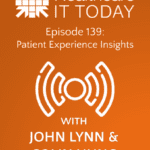 The following is a guest article by Patty Riskind, CEO at Orbita.
The following is a guest article by Patty Riskind, CEO at Orbita.
During a discussion among a group of industry leaders, one respected colleague said she wished we would all quit using terms like “disruption” and “transformation.” Why? Because it sends the message that the industry’s current performance is decidedly inadequate – and implies we need to completely start over.
I thought her viewpoint made sense. The truth is that – even if they wanted to – most healthcare organizations are not in a position to overhaul their infrastructure, business model and workflows. Instead, they must find ways to continue forward motion incrementally by working within current systems and processes while adopting integrative approaches to solve emerging problems.
That’s where digital strategies play a critical role. It’s old news that healthcare is facing unrelenting staff shortages, ever-tightening margins and growing patient frustrations. Rather than belabor these realities, many leaders instead are implementing technologies to serve as the connective tissue to bridge gaps created by these challenges.
Healthcare leaders likewise recognize that effective automation can give them a competitive edge. More and more consumer-oriented companies such as Amazon are entering the healthcare space. And patients demand the same personal attention from healthcare that they expect from other industries. A recent report from Cigna indicated 60% of consumers expect their digital healthcare experience to mirror that of retail – and 50% say that one bad digital experience with a healthcare provider ruins the entire experience with that provider. In another survey, 41% of respondents said they would stop going to their healthcare provider because of a poor digital experience.
Patient Access as a Use Case
One example of where automation can deliver significant results is patient access. The problem is many-faceted, but one approach is to ensure the organization can meet patients “where they are” – not just geographically, but also by simplifying the avenues through which patients can find information and care. This might mean adopting self-service, digital tools that provide answers to routine questions or help patients self-schedule appointments. In addition, healthcare needs to ensure patients can communicate in ways they prefer. Some individuals appreciate emails, while others want to text or use the phone. These preferences will become even more apparent as millennials and Gen Z-ers – who have grown up in a digital world – represent a larger portion of patients.
Digital tools that address these access needs also solve other problems. Because they leverage automation, demand on staff resources is lower. Fewer employees are needed to answer phones, book appointments or manage repetitive processes. In turn, this translates to lower costs – and improves patient satisfaction.
Key Considerations for Digital Success
So, if digital can help overcome a plethora of challenges and help maintain a competitive edge, how can healthcare organizations do it right? Here are several important considerations.
- Assess and prioritize areas where digital can make a measurable difference. One problem with terms like “transformation” or “disruption” is that they are imprecise: Exactly what needs to be transformed or disrupted? When exploring automation, leaders should evaluate and prioritize where these tools can have the greatest impact. These could include using a website-based virtual assistant designed specifically to help patients understand their symptoms, find the most appropriate care setting for their condition (e.g., next-day office appointment vs. emergency room visit) or identify the provider and location best suited for timely treatment. Alternatively, it could be interactive, multi-channel outreach (sequential email, text and voice communications) to assess patient status after a procedure to reduce the time nurses spend on these tasks.
- Look beyond immediate needs and break out of “silo thinking.” While outpatient surgery might need post-discharge outreach tools today, for example, other departments might decide they could benefit from similar automated processes in six months. New use cases likewise might arise that could be addressed with digital solutions – streamlining the difficult process of distributing patient intake and preparation forms, perhaps, and ensuring consent and information documents are in order before surgery. It makes sense for healthcare organizations to consider robust platforms that are agile and can easily be configured for emerging priorities.
- Make sure automated tools integrate with existing systems. Effective automation requires that digital tools interact seamlessly with other systems of record, including EMRs, CRMs and scheduling software. Frictionless automation means communications can flow from one system to another without forcing users – both staff and patient – to log in and out of various solutions. Consider a situation where a patient engages with a virtual assistant, but the interaction is escalated to a live agent. The transcript should be immediately available to the agent so patients do not have to repeat themselves and to ensure the representative has a comprehensive picture of the previous dialog.
- Don’t overlook the human element. Many healthcare leaders fear automation will sacrifice the human touch. Without a doubt, healthcare is inherently personal. Today’s tools employ natural language understanding so patients can use familiar words and phrases – while back-end intelligence translates this vocabulary into data appropriate for a clinician. In addition, virtual assistants can leverage deep knowledge bases and conversational AI to prompt patients for details that will help them navigate the system easily and appropriately, helping them feel understood and routing them to the assistance they need.
Today’s digital tools offer significant value to healthcare leaders. They provide empathetic and efficient solutions to real challenges. Most importantly, their adoption does not spell wholescale disruption. Instead, automation can be applied incrementally to solve immediate problems and then be extended to meet other needs. A well-considered digital strategy most often augments and improves existing processes – and may well result in happier staff and patients.













